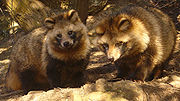
Japanese Raccoon Dog
Encyclopedia
The Japanese raccoon dog, also known as in Japanese, is conventionally considered as two subspecies
of the raccoon dog
, hondo-tanuki (Nyctereutes procyonoides viverrinus), and ezo-tanuki (Nyctereutes procyonoides albus). Their common Japanese name is often mistakenly translated into English as "badger
" or "raccoon
". Despite these mistranslations, the tanuki is not related to raccoons or badgers; the "raccoon-dog" is part of the evolutionary family that includes foxes
, wolves
, and dog
s.

 There is some debate in the scientific community regarding speciation
There is some debate in the scientific community regarding speciation
between the other subspecies of raccoon dog and the Japanese subspecies in that due to chromosome
, behavior
al and weight differences, the Japanese raccoon dog should be considered a separate species from the other subspecies.
Genetic analysis confirmed unique sequences of mtDNA, classifying the Japanese raccoon dog as a distinct isolation species, based on evidence of eight Robertsonian translocation
s. The International Union for Conservation of Nature Canid Group's Canid Biology and Conservation Conference in September 2001 rejected the classification of the Japanese raccoon dog as a separate species, but its status is still disputed, based on its elastic genome.
Subspecies
Subspecies in biological classification, is either a taxonomic rank subordinate to species, ora taxonomic unit in that rank . A subspecies cannot be recognized in isolation: a species will either be recognized as having no subspecies at all or two or more, never just one...
of the raccoon dog
Raccoon Dog
The raccoon dog , also known as the magnut or tanuki, is a canid indigenous to east Asia. It is the only extant species in the genus Nyctereutes...
, hondo-tanuki (Nyctereutes procyonoides viverrinus), and ezo-tanuki (Nyctereutes procyonoides albus). Their common Japanese name is often mistakenly translated into English as "badger
Badger
Badgers are short-legged omnivores in the weasel family, Mustelidae. There are nine species of badger, in three subfamilies : Melinae , Mellivorinae , and Taxideinae...
" or "raccoon
Raccoon
Procyon is a genus of nocturnal mammals, comprising three species commonly known as raccoons, in the family Procyonidae. The most familiar species, the common raccoon , is often known simply as "the" raccoon, as the two other raccoon species in the genus are native only to the tropics and are...
". Despite these mistranslations, the tanuki is not related to raccoons or badgers; the "raccoon-dog" is part of the evolutionary family that includes foxes
Fox
Fox is a common name for many species of omnivorous mammals belonging to the Canidae family. Foxes are small to medium-sized canids , characterized by possessing a long narrow snout, and a bushy tail .Members of about 37 species are referred to as foxes, of which only 12 species actually belong to...
, wolves
Gray Wolf
The gray wolf , also known as the wolf, is the largest extant wild member of the Canidae family...
, and dog
Dog
The domestic dog is a domesticated form of the gray wolf, a member of the Canidae family of the order Carnivora. The term is used for both feral and pet varieties. The dog may have been the first animal to be domesticated, and has been the most widely kept working, hunting, and companion animal in...
s.
Taxonomic dispute


Speciation
Speciation is the evolutionary process by which new biological species arise. The biologist Orator F. Cook seems to have been the first to coin the term 'speciation' for the splitting of lineages or 'cladogenesis,' as opposed to 'anagenesis' or 'phyletic evolution' occurring within lineages...
between the other subspecies of raccoon dog and the Japanese subspecies in that due to chromosome
Chromosome
A chromosome is an organized structure of DNA and protein found in cells. It is a single piece of coiled DNA containing many genes, regulatory elements and other nucleotide sequences. Chromosomes also contain DNA-bound proteins, which serve to package the DNA and control its functions.Chromosomes...
, behavior
Behavior
Behavior or behaviour refers to the actions and mannerisms made by organisms, systems, or artificial entities in conjunction with its environment, which includes the other systems or organisms around as well as the physical environment...
al and weight differences, the Japanese raccoon dog should be considered a separate species from the other subspecies.
Genetic analysis confirmed unique sequences of mtDNA, classifying the Japanese raccoon dog as a distinct isolation species, based on evidence of eight Robertsonian translocation
Robertsonian translocation
Robertsonian translocation is a common form of chromosomal rearrangement that in humans occurs in the five acrocentric chromosome pairs, namely 13, 14, 15, 21, and 22. Other translocations occur but do not lead to a viable fetus. They are named after the American biologist William Rees Brebner...
s. The International Union for Conservation of Nature Canid Group's Canid Biology and Conservation Conference in September 2001 rejected the classification of the Japanese raccoon dog as a separate species, but its status is still disputed, based on its elastic genome.

